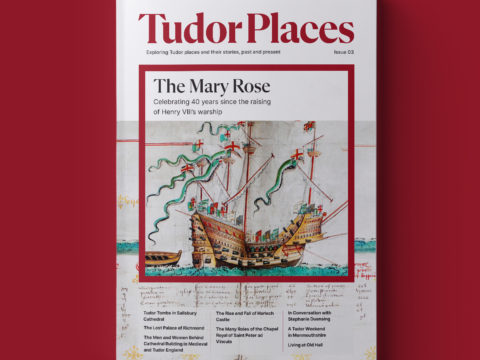Bess of Hardwick: Life Story
Chapter 16 : Last Years
Arbella was becoming increasingly unhappy and frustrated, seeing Bess as her gaoler. She hatched a plot to escape by marriage, choosing Edward Seymour, grandson of Lady Katherine Grey and Edward, Earl of Hertford. This was a phenomenally risky endeavour. Seymour had a claim to the throne. Partnered with Arbella, there was a realistic prospect of them being preferred to King James. Elizabeth would have no discussion of the succession, and severely punished any attempts to agree it.
A complex scheme was concocted to send the proposal to Lord Hertford. He was horrified when he received the message from Arbella and immediately reported it to the Queen and Council. A messenger was sent hot-foot to Hardwick. Arbella confessed, and Bess was beside herself with fear and anger, although she had been assured that Elizabeth held her completely uninvolved.
Bess asked Elizabeth to either send Arbella to somewhere she could be kept safely, or allow her to be married. The Queen rejected both requests, and in fact, thought that Arbella could be kept less strictly. Arbella’s own plea to the Queen to be allowed to come to court was also rejected.
Grandmother and granddaughter were effectively estranged. Arbella came up with another impractical scheme to escape, aided and abetted by the man Bess referred to as ‘my bad son, Henry.’ This too, came to nothing.
More letters to Elizabeth were effectively pointless, as, in the spring of 1603, the Queen, depressed at the death of her cousin and friend, Katherine, Lady Nottingham, succumbed to a throat infection and died, at the age of sixty-nine.
It was the end of an era, and Bess probably sincerely mourned the woman she had known for over fifty years, who had stood godmother to her son, and who had supported her through her difficult marriage to Shrewsbury.
Whatever hopes there might have been for Arbella were dashed. James VI succeeded as James I of England without incident. He bestowed his favour on Gilbert and Mary by staying with them at Worksop Manor on his journey south, which must have pleased Bess, even though she and they were estranged. He also signified his willingness to receive Arbella, and arranged for her to live with Henry Grey, Earl of Kent, and his wife at Wrest Park, Bedford. The departure of Arbella was probably simultaneously a relief and a grief to Bess.
Arbella soon joined the court, but found herself short of money. Bess was not inclined to help her, any more than she agreed to help her son Henry, even when requested to do so by Robert Cecil, now James’ chief minister.
In 1605, Bess fell ill, and Arbella obtained leave to visit her. There was the show of reconciliation between them, but Bess found it hard to forgive her granddaughter for her perceived lack of gratitude. This lack of family kindness continued, when Gilbert presented yet another suit against his stepmother, which Bess, accustomed to defending suits, and always scrupulous in observing the rules, won. However, it did not make relations any easier.
Similarly, whilst she would give Henry small presents when he visited, she would not clear his debts.
As Bess approached her late seventies, she was estranged from three of her children, all of whom would have welcomed reconciliation, whether from genuine affection or for pecuniary motives. Charles was solvent, so his wish to be on good terms with her was probably genuine – and the quarrel had only come about because of his support for Gilbert. A slight thaw occurred when Gilbert and Mary’s daughter, Lady Alathea Talbot, married the Earl of Arundel – the highest ranking earl in England.
Gradually, Bess and Mary Shrewsbury were reconciled, although Mary’s leanings towards Catholicism were anathema to her mother. Bess had always remained on good terms with the Shrewsbury’s children, and in late 1607, Gilbert and Mary were finally accepted as visitors again.
Bess may have felt mortality drawing on. Shortly after the visit, she took to her bed in the cold of an exceptionally severe winter. William, always the most dutiful, if the least interesting, of her sons, sat by her bed and noted down her last requests. Frances and Charles visited her, and she wept for joy at seeing them. She made a verbal bequest of £4,000 to Charles, for land for his children and 2,000 marks for Frances.
On 13th February 1608, Bess died. She had outlived her first husband by over sixty years, her second by fifty, her third by forty, and her last by seventeen. She had been born the daughter of a country gentleman, little richer than many yeoman, and died the richest woman in England, with her granddaughter a member of the royal family. Despite many quarrels and upsets, she had lived a life with much love and friendship and was respected and honoured by all her knew her.
She was buried with great ceremony, in the Church of All Saints, Derby.
Bibliography
de Lisle, Leanda, The Sisters who would be Queen: the Tragedy of Mary, Katherine, & Lady Jane Grey (Glasgow: HarperCollins e-books, 2008)
Durant, David N, Bess of Hardwick: Portrait of an Elizabethan Dynast (London: Littlehampton Book Services, 1977)
Lovell, Mary S, Bess of Hardwick: First Lady of Chatsworth (London: Little, Brown & Company, 2005)
Marshall, Rosalind Kay K, Queen Mary’s Women: Female Relatives, Servants, Friends and Enemies of Mary, Queen of Scots (Edinburgh: John Donald Publishers, 2006)
Office, Public Record, Calendar of State Papers: Domestic Series: Edward VI, 1547-1553 (United Kingdom: Stationery Office Books, 1992)
The Complete Correspondence, 1550-1608 (2013),
Whitelock, Anna, Elizabeth’s Bedfellows, Kindle edn (London: Bloomsbury Publishing PLC, 2013),
Elizabeth (Bess) Hardwick
Family Tree




